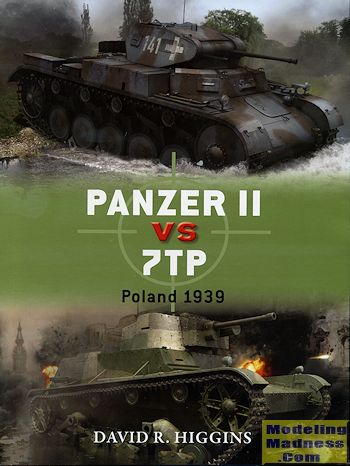 This latest
addition to Osprey's Duel series covers a pair of combatants during the early
days of WWII, the German Panzer II and the Polish 7TP. Both are light tanks and
both were mainly designed as either infantry support or reconnaissance tanks. As
is often the case in conflict, tank vs tank battles were not all that common
with most tanks being destroyed by anti-tank guns or other weapons.
This latest
addition to Osprey's Duel series covers a pair of combatants during the early
days of WWII, the German Panzer II and the Polish 7TP. Both are light tanks and
both were mainly designed as either infantry support or reconnaissance tanks. As
is often the case in conflict, tank vs tank battles were not all that common
with most tanks being destroyed by anti-tank guns or other weapons.
The 7TP was pretty much the result of the need for an armored
corps, but a lack of the sort of funding that was needed to produce a
world-beater tank. Still, the 7TP had several things going for it. It was
relatively well armed and it had a 37mm gun that could penetrate the armor of
many then current tanks. Indeed, this gun was enough to knock out even Germany's
early Panzer IV and made a mess of other German tanks when the conditions were
favorable. This was basically due to its being able to provide a penetrating
round at a reasonable distance.
The Panzer II, on the other hand, was developed to be a
relatively fast reconnaissance tank and was only armed with a 20mm main gun.
Sure, it could penetrate the armor of the 7TP, but it had to get pretty close to
do so. The Panzer I was even weaker and was pretty much nearing obsolescence
when the war began. Its machine gun calibre weapons were only useful against
soft targets. Such was the difference in offensive armament between the Panzer
II and the 7TP, that a considerable number of the German tanks were knocked out
during the brief Polish campaign.
As is often the case, the winners write history and the
Germans wrote that the Polish campaign was a cake-walk. Well, as reality often
brings to light, it was a much tougher campaign that we were led to believe. The
Poles had quality material, they just did not have the leadership that was
needed to take advantage of it. Things were also not helped by the Luftwaffe
gaining air superiority in the first week. This further decreased the
effectiveness of Polish armor as it could more easily be spotted from the air.
Add to it the invasion by the Soviets a few weeks into the war and the end was a
foregone conclusion.
In this duel series, we have a pair of fairly evenly matched
vehicles, though the Polish tank was generally superior. We get a nice
background on the situation in Poland and Germany that led to the development of
these vehicles and how they evolved until the end of Septemer 1939. To add spice
to the book, a look at a major section of the campaign shows how these two
vehicles were used by their respective armies. We also get a chance to see how
they performed in combat. Add to it the great period photos as well as some
great artwork, and you have a book that is interesting, entertaining, and that
busts a few myths along the way.
April 2015
For more on the complete line of Osprey books,
visit http://ospreygrp.com. In the US, it is
Osprey Direct at 443 Park Avenue South, New York, NY 10016, where you can
get a catalogue of available books.
If you would like your product reviewed fairly and quickly, please contact
me or see other details in the Note to
Contributors.
 This latest
addition to Osprey's Duel series covers a pair of combatants during the early
days of WWII, the German Panzer II and the Polish 7TP. Both are light tanks and
both were mainly designed as either infantry support or reconnaissance tanks. As
is often the case in conflict, tank vs tank battles were not all that common
with most tanks being destroyed by anti-tank guns or other weapons.
This latest
addition to Osprey's Duel series covers a pair of combatants during the early
days of WWII, the German Panzer II and the Polish 7TP. Both are light tanks and
both were mainly designed as either infantry support or reconnaissance tanks. As
is often the case in conflict, tank vs tank battles were not all that common
with most tanks being destroyed by anti-tank guns or other weapons.